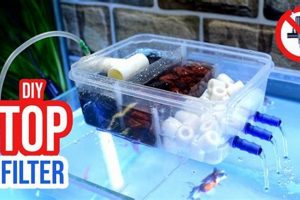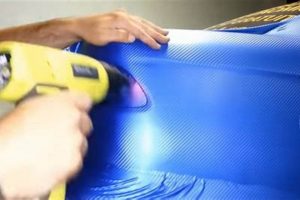The practice involves the manual or chemical removal of dead skin cells, excess sebum, and product buildup from the skin on the head, accomplished through methods prepared and applied by the individual at home. An example includes the creation and application of a scrub using ingredients like sugar and coconut oil.
This process promotes a healthier environment for hair follicles, potentially stimulating growth and alleviating conditions such as dandruff or itchy scalp. Historically, individuals have utilized natural remedies and homemade mixtures for hygiene and cosmetic purposes, evolving into the contemporary iterations of this specific exfoliating technique.
The following sections will delve into the various techniques, recipes, and considerations necessary to undertake this procedure safely and effectively, while addressing potential risks and necessary precautions.
DIY Scalp Exfoliation Guidance
Effective at-home scalp treatments require careful consideration and execution to ensure safety and optimal results. The following guidelines provide a framework for successful implementation.
Tip 1: Ingredient Selection: Prioritize natural, non-irritating components. Sugar, oatmeal, and salt are common abrasive agents. Carrier oils like coconut, olive, or jojoba can serve as bases, providing moisturization and facilitating gentle exfoliation.
Tip 2: Formulation Preparation: Maintain a balanced ratio of abrasive to base. An overly abrasive mixture can cause micro-tears and irritation, while an insufficient ratio may render the treatment ineffective. A 2:1 ratio of base oil to exfoliant is generally recommended.
Tip 3: Patch Testing: Before applying the treatment to the entire scalp, conduct a patch test on a small, inconspicuous area. Monitor for adverse reactions such as redness, itching, or inflammation for at least 24 hours.
Tip 4: Application Technique: Apply the mixture to a damp scalp, separating the hair into sections for thorough coverage. Use fingertips to gently massage the treatment into the scalp in circular motions for several minutes.
Tip 5: Rinsing Procedure: Ensure complete removal of the treatment. Residual particles can clog hair follicles and exacerbate scalp conditions. Use lukewarm water and a mild shampoo, if necessary.
Tip 6: Frequency Regulation: Limit exfoliation to once or twice per week. Over-exfoliation can strip the scalp of its natural oils, leading to dryness and irritation.
Tip 7: Tool Sanitation: If utilizing tools such as brushes or combs for the process, ensure they are thoroughly sanitized before and after use. This helps prevent the spread of bacteria and maintains scalp hygiene.
Adherence to these guidelines can contribute to a healthier scalp environment, potentially promoting hair growth and alleviating common scalp conditions. Consistent, yet cautious, application is key.
The subsequent sections will address potential risks and contraindications associated with at-home exfoliation, providing a comprehensive overview of the practice.
1. Ingredient Selection
Ingredient selection constitutes a foundational aspect of at-home scalp exfoliation. The materials chosen directly impact the efficacy and safety of the process. Incorrect selection can lead to adverse reactions, negating the intended benefits and potentially exacerbating pre-existing scalp conditions. For instance, utilizing overly abrasive agents like coarse salt on a sensitive scalp can cause micro-tears and irritation. Conversely, employing ingredients lacking exfoliating properties will render the procedure ineffective.
The importance of informed ingredient selection is further underscored by the variability in individual skin sensitivities and allergies. Some individuals may exhibit adverse reactions to commonly used ingredients such as certain essential oils or preservatives present in commercially available components. A practical example involves individuals with nut allergies, who must avoid using oils derived from nuts, such as almond or macadamia oil, in homemade exfoliation mixtures. Proper ingredient selection, therefore, necessitates careful consideration of individual skin types, allergies, and potential sensitivities.
In summary, the selection of appropriate ingredients forms a critical control point in at-home scalp exfoliation. A thorough understanding of ingredient properties, potential allergens, and individual skin sensitivities is essential for achieving the desired outcomes while mitigating potential risks. Prioritizing natural, non-irritating components and conducting patch tests before full application remain crucial practices for ensuring a safe and effective exfoliation experience.
2. Formulation Balance
Formulation balance is a critical determinant of success in the practice of creating scalp exfoliation treatments at home. The ratio of exfoliating agent to base ingredient directly affects the treatment’s efficacy and safety. An imbalance, such as an overabundance of abrasive particles, risks causing micro-abrasions and irritation to the scalp. Conversely, insufficient abrasive material diminishes the treatment’s ability to effectively remove dead skin cells and debris. A practical example illustrates this: a mixture containing too much sugar and too little oil may scratch the scalp, leading to redness and discomfort, whereas a mixture overly diluted with oil might provide insufficient exfoliation, rendering the effort futile. The careful calibration of these components is therefore essential.
The practical significance of understanding formulation balance extends beyond immediate comfort. Long-term effects of imbalanced formulations include potential damage to the hair follicles and disruption of the scalp’s natural oil production. Over-exfoliation, resulting from an overly abrasive mixture, can strip the scalp of its natural sebum, leading to dryness, inflammation, and potentially, increased susceptibility to infection. A balanced formulation, conversely, gently removes buildup without disrupting the scalp’s delicate ecosystem, promoting a healthier environment for hair growth. The selection of base ingredients must also be considered. Some oils may be more suitable for certain skin types; for example, jojoba oil mimics the scalp’s natural sebum and may be more beneficial for individuals with oily scalps, while coconut oil, though moisturizing, may clog pores for some individuals.
In summary, formulation balance is a fundamental consideration in scalp exfoliation treatments prepared at home. The correct ratio of exfoliating agent to base ingredient is crucial for achieving effective exfoliation without causing irritation or damage to the scalp. Challenges arise from individual differences in skin sensitivity and potential allergies, necessitating careful ingredient selection and patch testing. Ultimately, a balanced formulation supports
a healthy scalp environment and promotes optimal hair growth, emphasizing the critical role of meticulous preparation and informed decision-making.
3. Patch Testing
Patch testing functions as a crucial safety measure when engaging in homemade scalp exfoliation. This procedure involves applying a small amount of the prepared exfoliation mixture to a discreet area of skin, typically behind the ear or on the inner arm, to assess for adverse reactions before widespread application to the scalp. The primary objective of patch testing is to identify potential allergic reactions or sensitivities to any of the ingredients used in the DIY formulation. The skin on the scalp can be more sensitive than other areas of the body; therefore, a substance tolerated elsewhere may still provoke a reaction on the scalp.
Without prior patch testing, the consequences of applying an allergenic or irritating substance to the entire scalp can range from mild discomfort, such as itching and redness, to more severe reactions including inflammation, blistering, and even hair loss. For example, an individual may be unknowingly sensitive to a specific essential oil or a preservative used in a DIY scrub recipe. Applying the scrub directly to the scalp without patch testing could trigger an immediate allergic reaction, resulting in significant scalp irritation and potential long-term damage to hair follicles. Moreover, pre-existing scalp conditions like eczema or psoriasis can be exacerbated by ingredients that are otherwise harmless to individuals without these conditions.
In conclusion, patch testing is an indispensable step in DIY scalp exfoliation. By preemptively identifying potential irritants, it mitigates the risk of adverse reactions and promotes a safer and more effective exfoliation process. The implementation of patch testing aligns with a precautionary approach, prioritizing scalp health and minimizing the potential for negative outcomes when experimenting with homemade treatments.
4. Application Technique
Effective implementation of homemade scalp exfoliation hinges significantly on the application technique employed. The manner in which the exfoliating mixture is applied determines the extent of its contact with the scalp, influencing the efficacy of dead skin cell removal and follicle stimulation. Incorrect application can lead to uneven distribution of the product, resulting in inconsistent exfoliation and potentially causing localized irritation or inadequate treatment. A common example involves applying the scrub only to the hair strands instead of directly to the scalp, thereby negating the intended benefits. Thus, meticulous attention to the application process is essential for achieving desired outcomes.
The application technique also impacts the potential for scalp damage. Vigorous rubbing or excessive pressure during application can cause micro-tears in the scalp, leading to inflammation and irritation. Conversely, too gentle an approach may fail to dislodge dead skin cells and product buildup effectively. A recommended technique involves using fingertips to gently massage the exfoliating mixture into the scalp in circular motions, ensuring even coverage without applying excessive force. Sectioning the hair can further facilitate uniform application, particularly for individuals with thick or long hair. Utilizing specialized tools, such as silicone scalp massagers, may also enhance the process, provided they are used cautiously and cleaned thoroughly to prevent bacterial contamination.
In summary, the application technique constitutes a critical component of scalp exfoliation initiatives undertaken independently. Proper technique ensures uniform coverage, minimizes the risk of scalp damage, and maximizes the exfoliating potential of the chosen ingredients. A deliberate and gentle approach, combined with appropriate tools and hair sectioning, can significantly enhance the effectiveness and safety of homemade scalp treatments. Attention to this detail is a key differentiator between a successful and a potentially detrimental scalp care experience.
5. Rinsing Thoroughness
Adequate rinsing is an indispensable step in the execution of homemade scalp exfoliation. This process directly influences the removal of residual exfoliating agents and dislodged debris from the scalp and hair follicles. Incomplete rinsing can lead to product buildup, clogging follicles and potentially causing irritation, inflammation, or even hindering hair growth. The effectiveness of the exfoliation procedure is contingent upon the subsequent elimination of any remaining particles. For instance, sugar or salt granules, if left behind, can attract moisture and bacteria, creating an environment conducive to scalp infections.
The practical application of this principle necessitates the use of copious amounts of lukewarm water and careful attention to the scalp during the rinsing process. Sectioning the hair and thoroughly massaging the scalp while rinsing ensures that all areas are adequately cleansed. The use of a clarifying shampoo may be considered in instances where the exfoliating mixture is particularly dense or oily; however, its application should be judicious to avoid over-stripping the scalp’s natural oils. Individuals with thicker hair may find it beneficial to spend additional time rinsing to ensure the complete removal of residual particles. Real-world implications include the alleviation of scalp itchiness and the prevention of dandruff or seborrheic dermatitis flare-ups associated with product accumulation.
In conclusion, thorough rinsing constitutes a critical control point in the realm of homemade scalp exfoliation. The potential benefits of the procedure can be undermined or even reversed by inadequate rinsing practices. Adherence to this principle mitigates the risk of adverse reactions and promotes a healthier scalp environment. The challenge lies in striking a balance between effective cleansing and avoiding excessive dryness, which necessitates a personalized approach and careful monitoring of the scalp’s condition post-exfoliation.
6. Frequency Moderation
Frequency moderation represents a critical component of safe and effective at-home scalp exfoliation. The practice involves determining and adhering to an appropriate interval between exfoliation treatments to prevent over-stimulation and maintain scalp health. Over-exfoliation, a direct consequence of insufficient frequency moderation, can disrupt the scalp’s natural oil balance, leading to dryness, irritation, and potential inflammation. An example is an individual who exfoliates their scalp daily, believing it will accelerate hair growth, but instead experiences increased flakiness and an itchy scalp due to the stripping of essential oils.
Conversely, infrequent exfoliation may not provide adequate removal of dead skin cells and product buildup, potentially hindering hair follicle function and contributing to scalp conditions such as dandruff. The optimal frequency varies depending on individual factors, incl
uding scalp type, hair type, and the specific exfoliating agents used. Individuals with oily scalps may benefit from more frequent exfoliation compared to those with dry scalps. Furthermore, harsh chemical exfoliants typically necessitate less frequent application than gentler, natural scrubs. The practical application of this understanding involves careful monitoring of the scalp’s condition and adjusting the exfoliation schedule accordingly.
In summary, frequency moderation is essential for realizing the benefits of at-home scalp exfoliation while minimizing potential adverse effects. The challenge lies in tailoring the exfoliation schedule to individual needs and closely observing the scalp’s response. This careful balance ensures the maintenance of a healthy scalp environment, promoting optimal hair growth and overall scalp well-being. The connection between frequency moderation and scalp exfoliation lies in the need to maintain a healthy scalp to receive the full benefits of the treatment without causing negative effects.
Frequently Asked Questions
The following questions address common concerns and misconceptions regarding at-home scalp exfoliation practices, providing factual and objective information to guide informed decision-making.
Question 1: What are the potential risks associated with undertaking scalp exfoliation at home?
Potential risks include scalp irritation, inflammation, micro-tears, and allergic reactions. Over-exfoliation can disrupt the scalp’s natural oil balance, leading to dryness and increased sensitivity. Improper tool sanitation may introduce bacteria, causing infections.
Question 2: How often should scalp exfoliation be performed to achieve optimal results?
The frequency depends on individual scalp type, hair type, and the exfoliation method. Generally, exfoliation is recommended once or twice per week for oily scalps and less frequently for dry scalps. Careful monitoring of the scalp’s condition is essential to adjust the frequency as needed.
Question 3: What ingredients should be avoided in homemade scalp exfoliation mixtures?
Avoid harsh chemicals, artificial fragrances, and ingredients known to cause allergic reactions. Abrasive agents such as coarse salt or nut shells can damage the scalp. Prioritize natural, non-irritating components.
Question 4: Is it possible to exfoliate the scalp too much, and what are the consequences?
Yes, over-exfoliation can strip the scalp of its natural oils, leading to dryness, irritation, and inflammation. It can also disrupt the scalp’s microbiome and weaken hair follicles, potentially contributing to hair loss.
Question 5: How can one determine if a homemade scalp exfoliation mixture is suitable for their scalp type?
A patch test should be performed on a small, inconspicuous area of skin before applying the mixture to the entire scalp. Monitor for adverse reactions such as redness, itching, or inflammation for at least 24 hours. If no reaction occurs, the mixture is likely suitable.
Question 6: What are the signs that scalp exfoliation is being performed incorrectly or causing damage?
Signs of improper exfoliation include increased scalp sensitivity, redness, itching, inflammation, flakiness, and hair breakage. Persistent discomfort warrants discontinuation of the practice and consultation with a dermatologist or trichologist.
The judicious and informed application of at-home scalp exfoliation can contribute to a healthier scalp environment. However, awareness of potential risks and adherence to safe practices are paramount.
The subsequent section will provide a summary of key considerations for those engaging in DIY scalp care.
Concluding Remarks
This exploration of at-home scalp exfoliation has highlighted key aspects, ranging from ingredient selection and formulation balance to application techniques and frequency moderation. The understanding of potential risks and adherence to safe practices are crucial components for individuals undertaking this procedure. A patch test to determine sensitivity is essential before widespread application to the scalp.
The informed and judicious approach to scalp exfoliation can contribute to a healthier scalp environment, promoting optimal hair growth and overall well-being. Awareness of individual scalp conditions and appropriate consultation with a dermatologist or trichologist is always recommended. The future of scalp care lies in a personalized and responsible approach, prioritizing safety and effectiveness.







